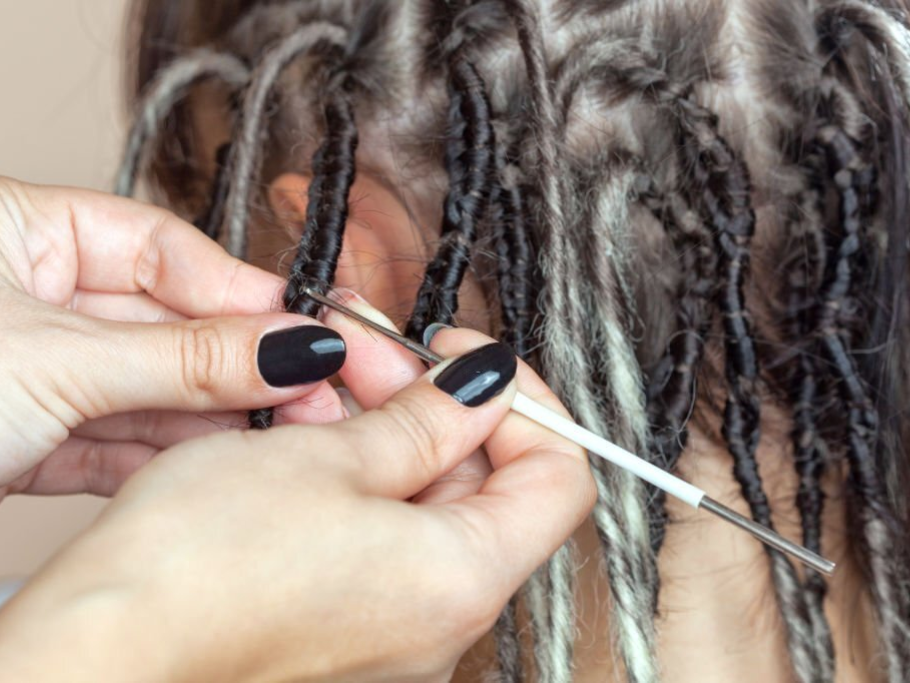Locs, also called dreadlocks or just dreads, are a great way to protect natural hair and wear it differently. For this hairstyle, pieces of hair are matted and knotted together to look like a rope. Even though the style is trendy, there is a lot you should know about how to do it and how to keep it looking good before you start.
There are many ways to care for natural hair locs and keep a crown full of healthy dreadlocks, whether you've been wearing locs for years or just started. Locs need to be moisturized just like any other natural hair, they are easy to do and can be worn as short natural hairstyles. Read further to learn about types of Locs and their maintenance.
What Are Locs?
For dreadlocks, you have to tuck loose hairs into the dread and lock it to the rest of your hair. How you take care of your dreadlocks will depend on how old they are and how you started them.
Types Of Locs
1. Free-Form Dreadlocks
People often call these the original dreads. They are made by not taking care of your hair. Just wash your hair and forget about it. These types of locs don't look like the most precise or even locs. The size of each lock is different, and some are even as big as a big man's wrist. Free-formed locs can be washed, but they are harder to keep clean because they are larger and are not styled. Free Forming has been linked to Rastafarians for a long time because of their religion.
2. Interlocks
The hair is parted and then "locked" by tying a knot at the very end of the hair, which works well for smaller locs. Then you slide your finger down the scalp to split the hair into two parts. Take the end of the hair and pull it through each loop you make from the bottom to the top. You work your way up the section of hair until it looks like it has been crocheted. You can also use a latch hook to do this. These types of locs are great and look wonderful.
3. Sisterlocs
Sisterlocks were made by Dr. JoAnne Cornwell, and they are often the smallest of the loc options. Sometimes these types of locs are as small as micro braids! The sizes can be different, but they are usually not very big. On natural or relaxed/chemically treated hair, hundreds of locks are put in and kept in place with a special tool and method.
4. Traditional Locs
Finger coils or comb curls can be used to start traditional locs. For a more uniform look, this can be done at home or by a pro. People usually keep these types of locs in place by applying a twisting gel and/or loc gel, twisting the hair at the root, and clipping it in place. You can also braid your hair afterward if you want to.
Stages Of Loc Hairstyles For Women
1. Starter or Baby Stage
You have to begin somewhere, and believe it or not, most people whose locs you admire start here. This phase can last anywhere from 3 to 6 months, depending on the texture of your hair and how fast it grows on its own. You can start your locs with braids, two-strand twists, or interlocking, but most start with finger coils. This stage might be one of the hardest types of locs, but if you are patient, you'll get through it.
2. Budding Stage
During the budding phase, you should start your routines and habits for taking care of your plant. You can gently re-twist the types of locs to help them lock, but you should not do this too often because it can break the locs and make them weak. Many people complain that their loc styles look puffy at first, but that's just the healthy new growth that you'll later twist into your carefully sectioned locs.
 Stages Of Loc Hairstyles For Women
Stages Of Loc Hairstyles For Women
3. Teen Stage
The first stirrings of pride and contentment may be upon you now. At this point, the loc hairstyles for women should be fully activated and resistant to untangling during regular shampooing. Although it will take some time for your loc styles to grow in the style you envisioned, you may take heart in the knowledge that you are well on your way and are just a few months away from the locs you planned to construct.
4. Mature Stage
Slowly, the teen stage gives way to the adult stage. Once your locs are fully grown, you can easily tell them apart, even if they are freeform. It may take a little longer, though. Now that the new growth knows where to go, it will start making your locs longer and giving them more shape. You should have found a way to care for your hair that fits your schedule and style by now. You can keep your locs looking and feeling healthy with regular shampooing, a great natural pre-cleanser, especially if you have a very active lifestyle, and an awesome conditioner.
5. Rooted Stage
At this point, you should know everything there is to know about your locs' tone, needs, and wants. You can start styling your locs in different ways to protect them, and if you dare, you can even trim your locs. At this point, your locs will feel heavier for sure. Keep your locs moist from the beginning to the end, and don't use any products that aren't natural and can cause buildup or dread rot. Finally, pat yourself on the back for reaching your goal, and enjoy the process as much as you love the result.
Loc Hairstyles Maintenance Tips
Like most natural styles, moisture will be key in maintaining dreadlocks at home. After all, dry hair is more prone to brittleness and breakage. Your best bet is to use hair oil on top of a moisturizing spray to keep dryness away. You can also try hot oil treatment that nourishes your hair and strengthens the roots.
The scalp is skin and needs the same protection that the skin on your body or face needs. Opt for lightweight oils that won't clog your pores or hair follicles, and sleep with a silk or satin bonnet and pillow. Wrapping dreadlocks at night will keep the style in place and help prevent frizz, dirt, and debris.
In the beginning, stages, make sure all dreads are twisted, and if they aren't, twist them a little until they are under a bit of tension. It is one of the important loc hairstyle maintenance tips. To twist:
- Spin the loc while applying some dread cream to the dread and work it around in a clockwise twist.
- Once twisted, pin or attach the dread to hold it in the twisted position until dry.
- Avoid twisting the same locs repeatedly, as too much tension can cause breakage.
Conclusion
Make dreadlocks out of your hair, and be creative! All types of locs are a lot of fun to play around with because they can be styled in so many different ways. You can make a fashion statement or show off your personality with dreadlocks. If you are feeling creative, start making dreadlocks and give your hair the personality it needs.

